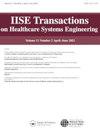Simulating cardiac arrest events to evaluate novel emergency response systems
IF 1.5
Q3 HEALTH CARE SCIENCES & SERVICES
IISE Transactions on Healthcare Systems Engineering
Pub Date : 2020-10-27
DOI:10.1080/24725579.2020.1836090
引用次数: 4
Abstract
Abstract This paper presents a simulation model approach to predict improvements in survival by new out-of-hospital cardiac arrest response systems. Poor cardiac arrest survival rates have motivated the exploration of new response system concepts to augment EMS systems, including citizen responders dispatched by a cell phone app, and the use of drones to deliver an AED to a cardiac arrest location. With few existing studies, the system effectiveness remains largely unknown. A predictive model was developed to understand the improvement these systems may have on cardiac arrest survival. The model uses a geospatial Monte Carlo sampling approach to simulate the random locations of cardiac arrests and the responding agents. The model predicts the response time of EMS, mobile dispatched responders, and drone AED delivery, based on the distance traveled and the mode of transit, while accounting for additional non-transit system factors. A logistic regression model is utilized to translate response times for CPR and defibrillation to a likelihood of survival. The model was developed to simulate and compare multiple response system concepts. The paper presents a case study to demonstrate the model’s utility.模拟心脏骤停事件以评估新型应急响应系统
摘要本文提出了一种模拟模型方法来预测新型院外心脏骤停反应系统的生存率提高。心脏骤停存活率低促使人们探索新的反应系统概念,以增强EMS系统,包括通过手机应用程序派遣的公民反应器,以及使用无人机将AED运送到心脏骤停地点。由于现有的研究很少,该系统的有效性在很大程度上仍然未知。开发了一个预测模型来了解这些系统可能对心脏骤停存活率的改善。该模型使用地理空间蒙特卡罗采样方法来模拟心脏骤停的随机位置和反应剂。该模型根据行驶距离和运输方式预测EMS、移动派遣响应者和无人机AED交付的响应时间,同时考虑其他非运输系统因素。逻辑回归模型用于将CPR和除颤的响应时间转化为存活的可能性。开发该模型是为了模拟和比较多种响应系统的概念。本文通过实例验证了该模型的实用性。
本文章由计算机程序翻译,如有差异,请以英文原文为准。
求助全文
约1分钟内获得全文
求助全文
来源期刊

IISE Transactions on Healthcare Systems Engineering
Social Sciences-Safety Research
CiteScore
3.10
自引率
0.00%
发文量
19
期刊介绍:
IISE Transactions on Healthcare Systems Engineering aims to foster the healthcare systems community by publishing high quality papers that have a strong methodological focus and direct applicability to healthcare systems. Published quarterly, the journal supports research that explores: · Healthcare Operations Management · Medical Decision Making · Socio-Technical Systems Analysis related to healthcare · Quality Engineering · Healthcare Informatics · Healthcare Policy We are looking forward to accepting submissions that document the development and use of industrial and systems engineering tools and techniques including: · Healthcare operations research · Healthcare statistics · Healthcare information systems · Healthcare work measurement · Human factors/ergonomics applied to healthcare systems Research that explores the integration of these tools and techniques with those from other engineering and medical disciplines are also featured. We encourage the submission of clinical notes, or practice notes, to show the impact of contributions that will be published. We also encourage authors to collect an impact statement from their clinical partners to show the impact of research in the clinical practices.
 求助内容:
求助内容: 应助结果提醒方式:
应助结果提醒方式:


